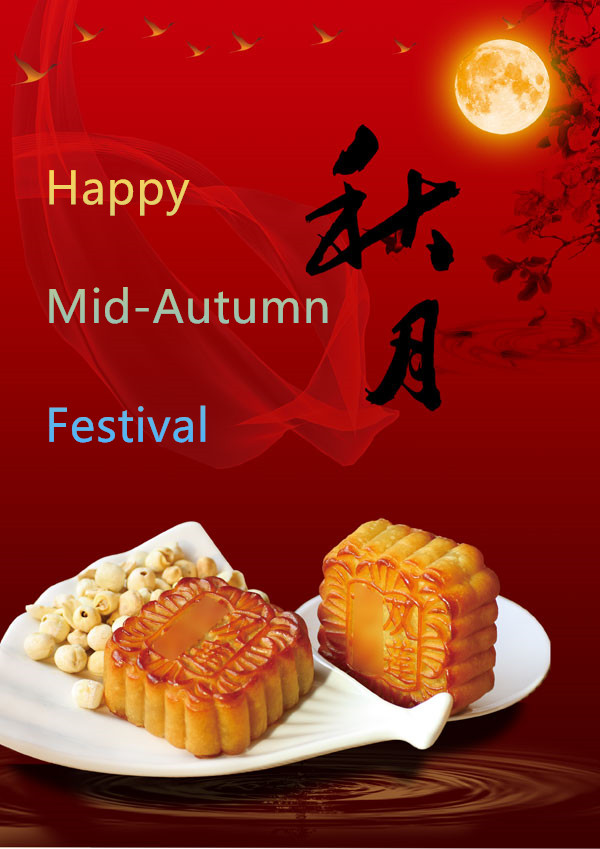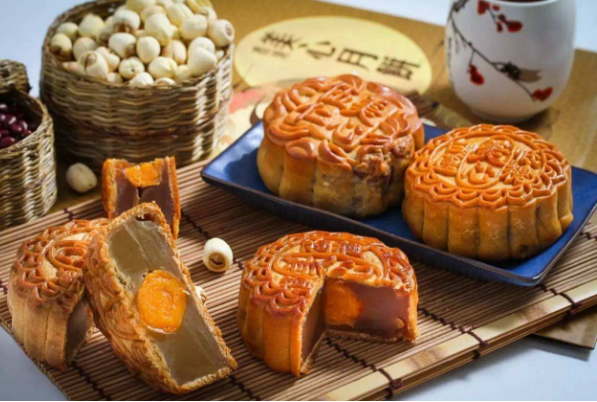The Mid-Autumn Festival, also known as lunar festival, Lunar birthday, Yuexi, Autumn Festival, Zhongqiu Festival, moon worship Festival, moon Festival, moon Festival, Reunion Festival, etc., is a traditional Chinese folk festival. The Mid-Autumn Festival comes from the celestial worship, from the ancient times autumn Festival on the evolution of the moon. The Mid-Autumn Festival has since ancient times to offer the moon, admire the moon, eat moon cakes, watch lanterns, admire osmanthus flowers, drink osmanthus wine and other folk customs, spread to this day, enduring Mid-Autumn Festival originated in ancient times, popular in the Han Dynasty, shaped in the early Tang Dynasty, prevailing in the Song Dynasty. The Mid-Autumn Festival is the synthesis of autumn seasonal customs, which contains the festival custom factors, mostly have ancient origins. The Mid-Autumn Festival to the moon round meanders reunion, as sustenance missing home, missing loved ones, hope for harvest, happiness, become a rich and colorful, precious cultural heritage. Originally, the “lunar festival” was held on the day of “Autumn Equinox”, the 24 solar terms of the Ganzhi calendar. Later, it was moved to the 15th day of August of the Xia calendar. The Mid-Autumn Festival, the Spring Festival, the Qingming Festival and the Dragon Boat Festival are known as the four traditional Chinese festivals. Influenced by Chinese culture, Mid-Autumn Festival is also a traditional festival in some countries in East Asia and Southeast Asia, especially the local Chinese. On May 20, 2006, The State Council included it in the first batch of national intangible cultural heritage list.
With the arrival of Mid-Autumn Festival, we also ushered in a three-day mini-holiday. We will have a three-day holiday from September 10th to September 12th.
If you have any needs, reply maybe not timely, you can choose to call us/whatsapp: 0086 18034554576

Historical origin
The Mid-Autumn Festival comes from the celestial worship, from the ancient times autumn Festival on the evolution of the moon. Offering to the moon, in our country is a very ancient custom, is a kind of worship to the “moon god” in some ancient places of our country. In the 24 solar terms of the autumn equinox season, is the ancient “festival”. The Mid-Autumn Festival comes from the traditional “autumn equinox”. As one of the important ceremonies of folk festivals, moon worship has gradually evolved into activities such as moon appreciation and moon praise.
So far, eating moon cakes is the essential custom of the Mid-Autumn Festival in all parts of China. Moon cakes symbolize reunion and are used as festival food to offer sacrifices to the moon and gifts to relatives and friends. In addition to moon cakes, all kinds of seasonal fresh and dried fruits are also delicious food on the autumn night. Mid-Autumn Festival, less clouds and fog, the moon is bright and bright, folk have the moon, moon offering, eating moon cakes, eating sweet potatoes, carrying lanterns, dancing grass dragon, tree Mid-Autumn Festival, laying bricks or stones pagoda and a series of festival activities.
The Customs of Mid-Autumn Festival
Eat moon cakes
According to the existing records, the custom of eating mooncakes originated from Tang Dynasty. Tang Xizong ate it on the Mid-Autumn Festival and felt it had the greatest taste, so he ordered the royal loyal house to package it with red loyal white cake and give it to the Xinke Jinshi. By the Song Dynasty, mooncakes had elegant names such as “lotus leaf”, “golden flower” and “lotus”, and were made in more elaborate ways. The poet Su Dongpo has a poem praised said: “cookies such as chewing month, there is crisp and Yi.” You can imagine how delicious it is.

Mid-Autumn Festival month
In ancient times, there was the custom of “autumn twilight evening month”. In the month, set a big incense, the moon idol on the moon that direction, high burning red candle, put on the moon cake, watermelon, apples, dates, plums, grapes and other offerings, the whole family in turn worship offerings to the moon, and then by the housewife cut reunion moon cake, the whole family how many people cut into how many pieces.
Enjoy the moon
Moonwatching comes from offering sacrifices to the moon. The folk moonwatching activity began about the Wei and Jin Dynasties, but it did not become a custom. In the Tang Dynasty, the Mid-Autumn Festival to enjoy the moon, play on the prevailing. When it came to the Song Dynasty, it formed a folk festival centered on moonwatching activities and was officially designated as the Mid-Autumn Festival. The middle autumn night of the Song Dynasty is a sleepless night, night market open all night, play on visitors, Dadan. Song people appreciate the moon more feeling things sad, often with cloudy or sunny circle, metaphor of human affairs, even if the Mid-Autumn night, the clear light of the moon also can not hide the sadness of Song people.

Eep Mid-Autumn festival
The internal candle of the mid autumn night lamp is tied to the bamboo pole with a rope, hung on the roof eaves or the terrace, or built with small lights in a zigzag or various shapes, hung on the height of the house, commonly known as “tree Mid-Autumn Festival” or “vertical Mid-Autumn Festival”. The lantern hanging in the rich house is high and countable zhang. The family members gather under the lamp and drink happily for fun. Ordinary people erect a flagpole and two lanterns to enjoy themselves. The city lights are like a glass world. Visible, from ancient times to the present Mid-Autumn Festival burning its scale seems to be second only to the Lantern Festival.
The Mid-Autumn festival bore
In ancient times, Zhejiang area in addition to the Mid-Autumn moon, tide is another Mid-Autumn Festival event. The custom of watching the Mid-Autumn Festival has a long history, as early as in the Han Dynasty knights of the “Seven hair” Fu has a quite detailed description. After the Han Dynasty, the wind of the Mid-Autumn Festival is more prosperous. The tideWATCHING RECORDS IN THE Supplementary Wulin Old Story BY ZHU Tinghuan IN Ming Dynasty AND Dream Liang Lu BY Wu Zimo in Song DYNASTY show that the tidewatching of Mid-Autumn Festival reached its peak in Song Dynasty.
Post time: Sep-09-2022
